
The plump, pretty blossoms of the crepe myrtle (Lagerstroemia indica) in whites, reds, oranges, pinks and purples hang languorously on the branch tips like Southern belles waiting to be asked to dance. The flowers are sufficient incentive for gardeners to grow this small tree in U.S. Department of Agriculture plant hardiness zones 7 though 9, but they are not the only associated blessing. A garden with a crepe myrtle also enjoys bird song. Birds flock to crepe myrtle trees to eat the ripe berries and also to feast on insect pests.
Description
Video of the Day
Gardeners find crepe myrtle cultivars to fit any sunny corner. The plants range from shrubs as short as 18 inches high to small trees; the tallest might grow to 40 feet, but 25 feet or under is the norm. In most specimens, the huge, showy flower clusters arrive in summer. The small brown or black seed berries ripen in autumn and can hang on the tree for several months. They are beloved by birds including catbirds and cardinals.
Video of the Day
Aphids
Crepe myrtle attract aphids. While aphids attack most plants, they favor crepe myrtle to such a degree that nurseries plant the shrubs to attract aphids from other plants. The crepe myrtle aphids (Tinocallis kahawaluokalani Kirkaldy) flock to the shrubs from spring through fall, feeding on the undersides of leaves by sucking plant sap with their needlelike mouthparts. Their saliva causes yellow spots on the leaves and stunts new growth. The sugary substance aphids secrete is termed honeydew, and it attracts ants, wasps and flies. To encourage birds to your tree, do not control aphids with anything stronger than water.
Aphid-Eating Birds
While your neighbors appreciate the gorgeous flower clusters your crepe myrtle offers, local birds flock to the tree first and foremost for the ever-ready supply of aphids. Every gardener knows that lady bugs are aphid predators, but many birds also appreciate the yellow-green insects. Finches, mockingbirds and woodpeckers are regular aphid customers. Chickadees, titmice and warblers also include aphids in their diets.
Bird Predators of Japanese Beetle
The Japanese beetle (Popillia japonica Newman) is a stunning bug, about 1/2-inch in length with copper-colored wings and a beautiful metallic-green body. Their larvae live underground and consume crepe myrtle rootlets, while adult beetles frequent sunny leaves and munch the tissue between the leaf veins. Natural insect predators include wheel bugs and praying mantis, but birds also arrive to share the feast; look for beetle-loving birds such as robins, crows, grackles, starlings and song sparrows.
- Texas A&M: Cooperative Extension: Insect Pests of Crape Myrtles and Suggestions for Their Control
- Carroll County Times: Crepe Myrtle Tree an Attraction for Backyard Birds
- Arbor Day Foundation: Crapemyrtle, Common Lagerstroemia Indica
- Floridata: Lagerstroemia Indica
- Gardeners Supply Company: How to Attract Bug-Eating Birds
- Fine Gardening: Langerstroemia Indica (Crape Myrtle)
- United States National Arboretum: Crepemyrtle Questions
- Northcoast Gardening: Simple Things You Can Do
- Fine Gardening: Keep Beneficial Insects, Birds and Mammals Around By Creating a Host Environment